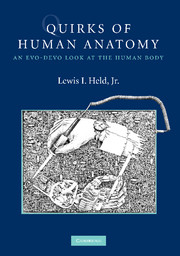Book contents
- Frontmatter
- Contents
- Preface
- CHAPTER 1 BACKGROUND
- CHAPTER 2 SYMMETRY AND ASYMMETRY
- CHAPTER 3 MYSTERIES OF THE MIDLINE
- CHAPTER 4 MERISM AND MODULARITY
- CHAPTER 5 SEXUAL DIMORPHISMS
- CHAPTER 6 SILLY, STUPID, AND DANGEROUS QUIRKS
- CHAPTER 7 MIND AND BRAIN
- EPILOGUE
- APPENDIX: QUIRKS OF HUMAN BEHAVIOR
- References
- Index
CHAPTER 1 - BACKGROUND
Published online by Cambridge University Press: 05 August 2012
- Frontmatter
- Contents
- Preface
- CHAPTER 1 BACKGROUND
- CHAPTER 2 SYMMETRY AND ASYMMETRY
- CHAPTER 3 MYSTERIES OF THE MIDLINE
- CHAPTER 4 MERISM AND MODULARITY
- CHAPTER 5 SEXUAL DIMORPHISMS
- CHAPTER 6 SILLY, STUPID, AND DANGEROUS QUIRKS
- CHAPTER 7 MIND AND BRAIN
- EPILOGUE
- APPENDIX: QUIRKS OF HUMAN BEHAVIOR
- References
- Index
Summary
If aliens had surveyed Earth 10 million years ago (MYA), they might have concluded that our planet not only lacked intelligent life but also had no obvious prospects for acquiring any. After all, how could they have known that East Africa would dry out, forcing some of its hairy tree dwellers to venture onto the plains, walk upright, utter sentences, make tools, and build skyscrapers?
What role did chance play in our origin
It is sobering to think that our species might never have arisen without the timely uplift and desiccation of the Rift Valley [341], but that incident was only the latest in a long string of haphazard events that made humanity possible [515]. Indeed, the African continent itself only emerged by chance when Gondwana cracked randomly into half a dozen pieces ∼ 140 MYA [1450, 2662]. Our luckiest break was undoubtedly 65 MYA when a wayward meteor collided with Earth, killing off the ruling reptiles and making room for our mammalian ancestors to spread, colonize, multiply, and diversify.
If we ever do encounter aliens on our future voyages into outer space, they might be able to deduce our home planet just by studying our bodies and behavior. They could guess Earth's mass from the thickness of our bones, the depth of its atmosphere from the size of our diaphragm, the rate of its rotation from our sleep-wake cycle, and the spectrum of its sun by the optics of our eyes.
Humans are not alone in bearing the stamp of our planet in our anatomy.
- Type
- Chapter
- Information
- Quirks of Human AnatomyAn Evo-Devo Look at the Human Body, pp. 1 - 16Publisher: Cambridge University PressPrint publication year: 2009



